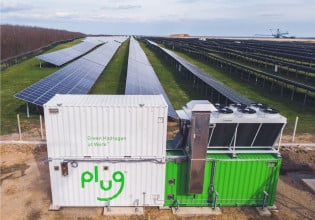Sweden Discovers Largest Rare Earth Element Deposit in Europe
The recent discovery of Europe's largest deposit of rare earth elements could help move electrification forward.
A Swedish Mining company called LKAB has discovered what may be Europe’s largest deposit of rare earth elements. Located in the Kiruna area of Sweden, the Per Geijer deposit is co-located with a large iron mine 600 miles north of Stockholm and operated by the Swedish government-owned mining company LKAB. No rare earth elements are presently mined in Europe, but a recent European Commission (EC) assessment indicated that the European demand for rare earth elements would increase by a factor of five by 2030.

The Per Geijer deposit is co-located with a large iron mine 600 miles north of Stockholm. Image used courtesy of LKAB
What Are Rare Earth Elements?
Rare earth elements are somewhat confusing. First of all, the name. These 17 metallic elements (15 in the periodic table's lanthanide series) are not particularly rare. They are located in deposits in many places on Earth; however, they are often tightly mixed with other materials, making it difficult and costly to extract and process them.
China extracts 60 percent of the rare earth minerals and processes 87 percent of the supply globally, according to the International Energy Agency (IEA).
The U.S. government has prioritized the production of these critical materials, but the U.S. currently produces just 15 percent of the global output, nearly all of which is sent to China for processing.

The Mendeleev periodic table: rare earth elements or lanthanides. Image used courtesy of Adobe Stock
Rare Earth Elements in EVs
Another misconception about rare earth elements is their role in electric vehicles. Rare earth is frequently mentioned as a limiting factor in EV growth. They are frequently mentioned as a necessity in producing lithium-ion batteries that store electrical energy, but this is completely false. The magnets in the traction motor in an EV contain rare earth elements, typically neodymium and dysprosium, in amounts of around 4 pounds in a typical EV. Rare earth additions make magnets much more powerful and can aid in their resistance to higher temperatures. It is possible to make an induction motor for an EV that does not use a permanent magnet; however, such motors are typically less efficient—a critical factor when building EVs with the longest possible range.
In addition to EVs, rare earth elements are used in the magnets of wind turbine generators (a 2-megawatt (MW) generator can have more than 750 pounds of rare earths) and are critical in advanced military hardware (an F35 fighter has up to 900 pounds of rare earth elements in its communications and targeting equipment.)
This brings us back to LKAB in Sweden. According to the company, the rare earth resources in the Per Geijer deposit at the Kiruna site could exceed one million tons of rare earth oxides—that would make it the largest deposit of rare earth elements in Europe with the potential to meet much of the EU’s future demand to make the permanent magnets that will be needed for EVs and wind turbines.

The industry depends on mining for rare earth elements. Image used courtesy of Adobe Stock
Naturally, it isn’t as simple as making a hole in the ground to get at the critical materials. For its initial work, the company has already created an exploratory tunnel several kilometers long at a depth of 700 meters (2300 feet), going from the existing Kiruna iron mine into the area of interest. The next step, later this year, will be to obtain the necessary permits to begin an operation on the surface to determine the depth and extent of the rare earth oxide deposits.
The Future of Sweden’s Rare Earth Elements
Based on the permitting process of similar types of mining operations, LKAB says it will be “at least 10-15 years” before the mine will begin delivering raw materials. This time frame could be dramatically reduced if the Critical Raw Materials Act, currently worked on by the European Commission (EC), finds ways to accelerate the permitting process.
In addition to the rare earth oxides located within the iron ore deposits, LKAB also reports that the surrounding rocks also contain high levels of phosphorous, which is a material used in certain types of lithium-ion batteries and that will be in critical supply as the electrification revolution moves forward—another incentive for the EC to act quickly.






